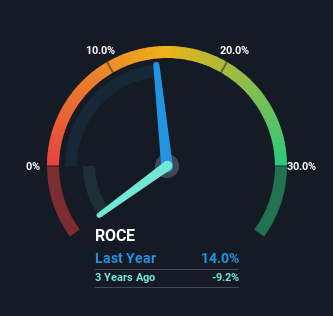- India
- /
- Professional Services
- /
- NSEI:CADSYS
Returns On Capital Signal Tricky Times Ahead For Cadsys (India) (NSE:CADSYS)
To find a multi-bagger stock, what are the underlying trends we should look for in a business? Firstly, we'll want to see a proven return on capital employed (ROCE) that is increasing, and secondly, an expanding base of capital employed. Ultimately, this demonstrates that it's a business that is reinvesting profits at increasing rates of return. Having said that, from a first glance at Cadsys (India) (NSE:CADSYS) we aren't jumping out of our chairs at how returns are trending, but let's have a deeper look.
What Is Return On Capital Employed (ROCE)?
For those that aren't sure what ROCE is, it measures the amount of pre-tax profits a company can generate from the capital employed in its business. To calculate this metric for Cadsys (India), this is the formula:
Return on Capital Employed = Earnings Before Interest and Tax (EBIT) ÷ (Total Assets - Current Liabilities)
0.14 = ₹218m ÷ (₹2.5b - ₹901m) (Based on the trailing twelve months to March 2024).
So, Cadsys (India) has an ROCE of 14%. On its own, that's a standard return, however it's much better than the 11% generated by the Professional Services industry.
Check out our latest analysis for Cadsys (India)

Historical performance is a great place to start when researching a stock so above you can see the gauge for Cadsys (India)'s ROCE against it's prior returns. If you'd like to look at how Cadsys (India) has performed in the past in other metrics, you can view this free graph of Cadsys (India)'s past earnings, revenue and cash flow.
How Are Returns Trending?
When we looked at the ROCE trend at Cadsys (India), we didn't gain much confidence. To be more specific, ROCE has fallen from 21% over the last five years. Although, given both revenue and the amount of assets employed in the business have increased, it could suggest the company is investing in growth, and the extra capital has led to a short-term reduction in ROCE. If these investments prove successful, this can bode very well for long term stock performance.
While on the subject, we noticed that the ratio of current liabilities to total assets has risen to 37%, which has impacted the ROCE. If current liabilities hadn't increased as much as they did, the ROCE could actually be even lower. Keep an eye on this ratio, because the business could encounter some new risks if this metric gets too high.
Our Take On Cadsys (India)'s ROCE
While returns have fallen for Cadsys (India) in recent times, we're encouraged to see that sales are growing and that the business is reinvesting in its operations. And the stock has done incredibly well with a 402% return over the last five years, so long term investors are no doubt ecstatic with that result. So should these growth trends continue, we'd be optimistic on the stock going forward.
If you want to know some of the risks facing Cadsys (India) we've found 4 warning signs (2 are concerning!) that you should be aware of before investing here.
While Cadsys (India) isn't earning the highest return, check out this free list of companies that are earning high returns on equity with solid balance sheets.
New: AI Stock Screener & Alerts
Our new AI Stock Screener scans the market every day to uncover opportunities.
• Dividend Powerhouses (3%+ Yield)
• Undervalued Small Caps with Insider Buying
• High growth Tech and AI Companies
Or build your own from over 50 metrics.
Have feedback on this article? Concerned about the content? Get in touch with us directly. Alternatively, email editorial-team (at) simplywallst.com.
This article by Simply Wall St is general in nature. We provide commentary based on historical data and analyst forecasts only using an unbiased methodology and our articles are not intended to be financial advice. It does not constitute a recommendation to buy or sell any stock, and does not take account of your objectives, or your financial situation. We aim to bring you long-term focused analysis driven by fundamental data. Note that our analysis may not factor in the latest price-sensitive company announcements or qualitative material. Simply Wall St has no position in any stocks mentioned.
Have feedback on this article? Concerned about the content? Get in touch with us directly. Alternatively, email editorial-team@simplywallst.com
About NSEI:CADSYS
Cadsys (India)
A knowledge process outsourcing company, provides knowledge solutions in India and internationally.
Moderate risk and slightly overvalued.
Similar Companies
Market Insights
Community Narratives



